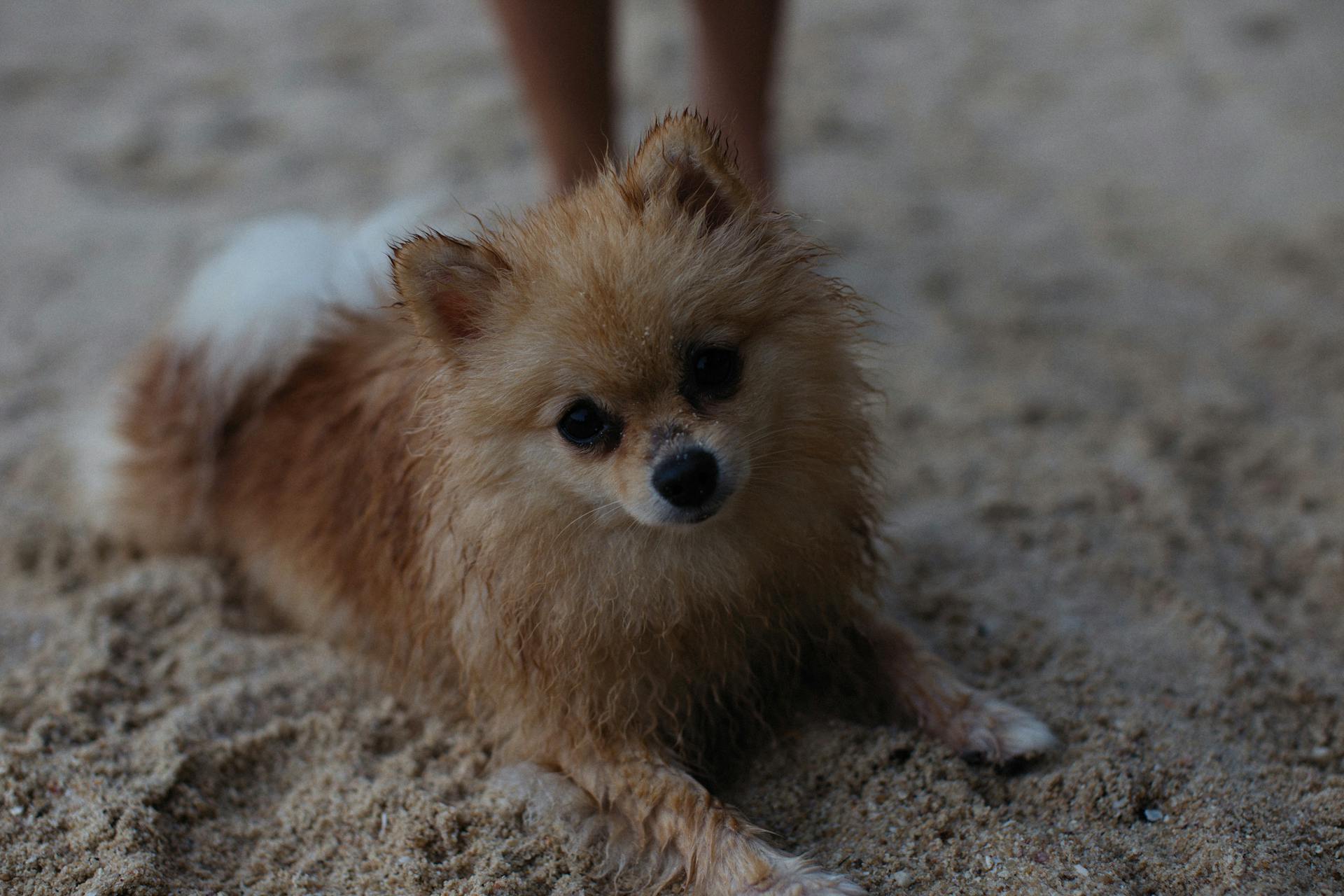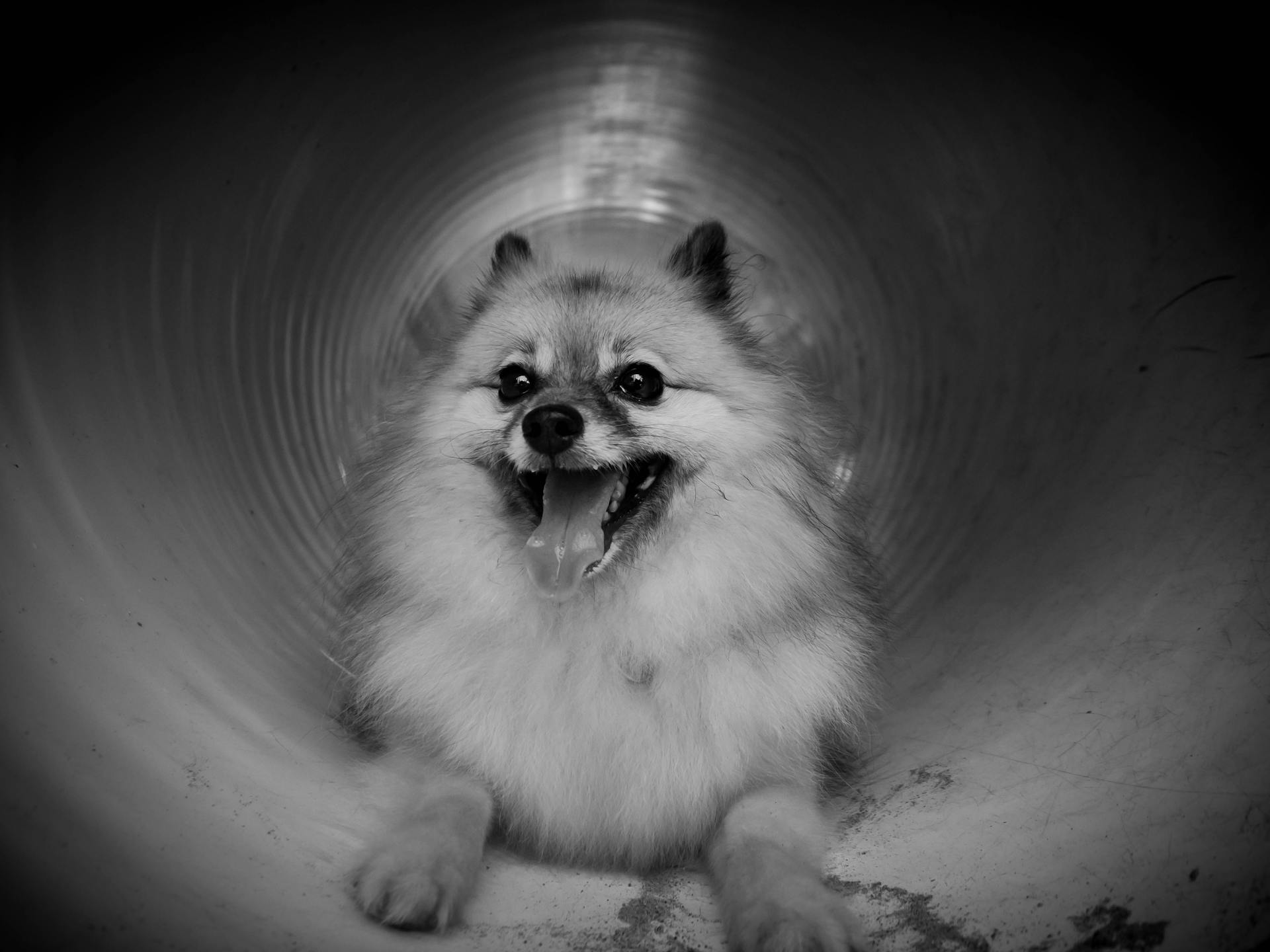
Pomeranians have a rich history that spans over 400 years, originating from the region of Pomerania in Central Europe.
They were initially bred as working dogs, specifically as sled dogs and herders.
Their small size and thick coats made them well-suited for these tasks.
The Pomeranian's ancestors were much larger than the breed we know today, weighing up to 30 pounds.
Over time, breeders selectively bred them to create the smaller, more compact dog we see today.
The Pomeranian's popularity soared in the 19th century, particularly among European royalty and aristocracy.
Queen Victoria was particularly fond of the breed and owned many Pomeranians during her reign.
This royal connection helped to further establish the Pomeranian as a beloved companion dog.
The History of Pomeranians
The Pomeranian is a descendant of spitz-type sled dogs from Iceland and Lapland (Finland).
These Pom predecessors made their way to Pomerania, located in what is now Poland and Germany, several hundred years ago.
The modern Pom is the smallest spitz-type dog breed.
Queen Victoria became a breeder and won a dog show with a particularly small Pomeranian in the late 1800s.
The Pomeranian's popularity rose when members of the British royal family took a liking to the small dogs.
The breed was still larger than today's version, weighing around 30 pounds, at that time.
Two Pomeranians were among the three dogs who survived the sinking of the Titanic in 1912.
The AKC recognized the breed in 1888.
Pomeranian Characteristics
Pomeranians are known for their bold and lively temperament, which is often bigger than their small size. They're quite vocal, making them potentially great alert watchdogs, but also a challenge for apartment or condo dwellers due to excessive barking.
Pomeranians are affectionate with their family and may form a strong bond with one person. However, they're not the best option for a first-time dog parent.
Here's a breakdown of their characteristics:
Physical Traits
Pomeranians have a compact, muscular body type, typically weighing between 3-7 pounds.
Their small size makes them a perfect companion for city dwellers or those with limited living space.
Their double coat is thick and dense, with a soft undercoat and a harsh outer coat that sheds heavily.
Pomeranians come in a variety of colors, including orange, red, blue, and black.
Their head shape is wedge-shaped, with a flat skull and a black nose.
Their ears are triangular and erect, always standing upright.
Their eyes are dark and almond-shaped, often described as "bright and expressive".
Their tail is plume-like and carried high.
Explore further: Black Pomeranian Dog Pictures
Personality and Temperament
Pomeranians have a bold and lively temperament, which is much bigger than their small size. They're quite vocal and can act as alert watchdogs.
Their personality is such that they tend to be affectionate with family, but may bond tightly with one person. This can make them a great companion for someone, but not ideal for a first-time dog parent.
Pomeranians are not the best option for apartment or condo dwellers due to their excessive barking. They have a high tendency to bark, which can be an issue.
Here's a breakdown of their personality traits:
Pomeranian Popularity
The Pomeranian has been a beloved breed in the United States, consistently ranking in the top 20 of registered American Kennel Club dog breeds since 1998. In fact, it was ranked #10 that year, and while it did drop a few spots over the years, it remained in the top 20 until 2015.
One notable year was 2011, when the breed fell to #17 in the rankings. It's interesting to note that this was a decline of two spots from the previous year. The Pomeranian's popularity has been relatively stable in the US, but it's worth noting that its popularity in other countries has fluctuated.
Here's a brief look at the Pomeranian's popularity in other countries:
- The Pomeranian is not listed in the top 20 breeds in the UK in either 2007 or 2008.
- In Australia, the breed's popularity peaked in 1987 with 1,128 registrations, but declined to 577 registrations by 2008.
It's clear that the Pomeranian has a loyal following in the US, but its popularity varies in other parts of the world.
Rise to Fame
The Pomeranian's rise to fame can be attributed to Queen Charlotte's love for the breed in the 18th century. She was so enamored with the Pomeranian that she even had them bred in various colors to match her wardrobe.
In the 19th century, the Pomeranian became a favorite among European royalty, with Queen Victoria being a notable fan. She owned many Pomeranians and even had them featured in her artwork and literature.
The Pomeranian's popularity continued to grow in the 20th century, with the breed being recognized by the American Kennel Club in 1903. This marked a significant milestone in the breed's history, paving the way for its widespread recognition and adoption.
Today, the Pomeranian is one of the most recognizable breeds in the world, with a distinctive appearance and charming personality.
Current Status
Pomeranians have been a popular breed for over a century, with their popularity peaking in the 1990s. They have been a top 10 breed in the American Kennel Club's (AKC) annual list of most popular breeds since 1996.
The AKC reported a significant increase in Pomeranian registrations in the early 2000s, with over 30,000 dogs registered in 2005 alone. This surge in popularity can be attributed to their small size and adaptable nature.

Pomeranians have also become a staple in the world of celebrity ownership, with many famous owners including Paris Hilton and Britney Spears. Their tiny size and big personality make them a favorite among the rich and famous.
Despite their popularity, Pomeranians are still a relatively rare breed, making up only about 1% of all dogs registered with the AKC. This rarity, combined with their small size, makes them a highly sought-after breed among dog enthusiasts.
Breed Overview
The Pomeranian is a small but mighty breed that's perfect for city living. They typically stand between 6 to 7 inches tall.
Their weight can vary, ranging from 3 to 7 pounds, making them a great companion for apartment dwellers.
Their beautiful coat is a double coat, which means it's long and fluffy, requiring regular grooming to prevent matting.
You'll find Pomeranians in a wide range of colors, including red, orange, cream, sable, black, brown, and blue. They're truly a colorful breed!
With proper care, Pomeranians can live up to 12 to 16 years, making them a long-term companion.
Pomeranian History
The Pomeranian's history is a fascinating one. The breed originated from spitz-type sled dogs from Iceland and Lapland, Finland.
These dogs made their way to Pomerania, located in what is now Poland and Germany, several hundred years ago. Breeders there reduced the dogs' size.
The modern Pomeranian is the smallest spitz-type dog breed. It's related to the Samoyed, Norwegian elkhound, and keeshond.
The breed's popularity rose when members of the British royal family fell in love with the small dogs. They were still larger than today's version, weighing around 30 pounds.
Queen Victoria was a key figure in making the breed even smaller, winning a dog show with a particularly small Pomeranian in the late 1800s.
Pomeranian Origin
The Pomeranian breed has a rich history that spans centuries. It is believed to have originated from the German Spitz, with the first recorded reference to the breed dating back to 1764 in James Boswell's diary entry.
Pomeranians were initially bred as working animals, used for herding and pulling sleds. However, breeders soon began to select for smaller dogs, leading to the modern Pomeranian we know today.
Queen Charlotte, Queen-consort of King George III, is credited with introducing Pomeranians to England in 1767. She brought two Pomeranians, Phoebe and Mercury, to the country.
The Pomeranian breed was further popularized by Queen Victoria, who established a large breeding kennel and imported smaller Pomeranians from various European countries. Her favorite Pomeranian, a red sable named Marco, weighed only 12 pounds and was exhibited in 1891.
Here's a brief timeline of the Pomeranian breed's history:
The Pomeranian breed has come a long way since its origins as a working animal. Today, it is a beloved companion dog, cherished for its small size and big personality.
Frequently Asked Questions
Which queen bred the Pomeranians?
Queen Victoria was a notable breeder of Pomeranians, specifically acquiring one named Turi in 1893.
What breeds make up a Pomeranian?
Pomeranians are related to breeds like Keeshond, Samoyed, and Norwegian Elkhound, all of which originated from early sled-dog ancestors. They were bred down from a larger sheepdog in the 19th century in the duchy of Pomerania.
Sources
- https://ampomclub.org/the-history-of-the-pomeranian/
- https://en.wikipedia.org/wiki/Pomeranian_dog
- https://www.akc.org/dog-breeds/pomeranian/
- https://www.thesprucepets.com/pomeranian-dog-breed-profile-1117987
- https://www.petexpress.com.ph/blogs/lifestyle/a-dog-breed-guide-to-the-feisty-and-adorable-pomeranian
Featured Images: pexels.com


